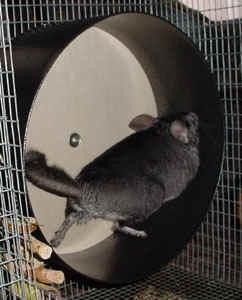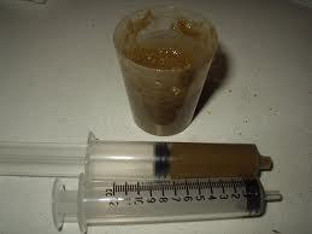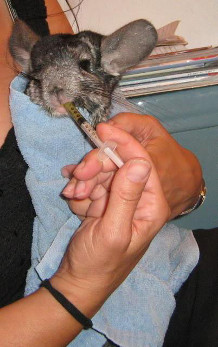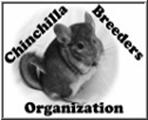Symptoms
Causes and Prevention
When to See the Veterinarian
Treatment
Medications
Other items needed
Schedule
Causes and Prevention
When to See the Veterinarian
Treatment
Medications
Other items needed
Schedule
Constipation in chinchillas can be a very serious condition. There are many reasons a chinchilla can become constipated and preventing constipation is often quite simple. Treatment is rather basic as long as a more serious cause is not the problem. In the instance of a more serious cause or prolonged constipation, veterinarian treatment is a must in order to save the chinchilla’s life.
Symptoms

Normal Chinchilla Feces
Causes and Prevention
The causes of constipation are varied and many are fairly easy to prevent. Some of the causes include an improper diet, too many or inappropriate treats, a sudden change of feed, dehydration, illness or pain, stress, lack of exercise, hairballs and the ingestion of a foreign object.
Chinchillas have digestive systems that process a relatively narrow range of food. A proper diet for chinchillas is low fat, low protein, low calorie and high in fiber. This is usually provided through pellets and hay. Anything outside of this range can cause constipation since the chinchilla is not capable of digesting it properly. Chinchillas should always have access to plenty of quality pellets and either loose or cubed hay. When a chinchilla does not get enough fiber in their diet, the digestive system slows down causing constipation. Inappropriate foods that contain sugar and/or high amounts of fat or protein can all have this effect. To help prevent constipation, a chinchilla should always have access to unlimited quality pellets and hay and should not be fed items such as meats, nuts and seeds, vegetables or fruit, or any type of junk food made for humans.
Inappropriate or too many treats can have the same effect as an inappropriate diet. As mentioned previously, chinchillas cannot properly digest any foods that contain fruits, vegetables, nuts, seeds dairy products, or meat. These items should never be used as regular food or treats since they can cause severe digestive issues such as constipation, diarrhea, bloat, blockages and stasis. Additionally, treats that are considered healthy for them, such as cheerios and shredded wheat, can cause problems if too many are fed either over time or all at once. A good rule of thumb is to feed only one or two treats a week. This means one or two total, not one or two of each kind of treat.
Sudden feed changes are another cause of constipation. When sudden changes are made, the chinchilla may not eat well or at all right after the switch. This can be as simple as the chinchilla waiting for the owner to bring more of the old food. If a sudden switch is necessary, do not return to feeding the old food. Instead, wait the chinchilla out and provide plenty of hay. The chinchilla will not starve itself. It will eventually eat the new food. The best way to avoid this problem is to change food gradually by mixing the new food in with old over a period of weeks.
Constipation can also be caused by dehydration. Chinchillas need to have access to clean water at all times. If a chinchilla is forced to go without, the digestive system will slow down due to lack of water necessary to process the food. If this is allowed to go on for too

Left to Right: Small, Hard Droppings Indicative
of Constipation; Skinny Droppings with Pinched Ends
Indicating Straining and Difficultly in Passing Stool;
Normal Chinchilla Droppings
As with people, when a chinchilla is sick or in pain, they often will not eat due to a lack of appetite. This is quite normal. Keep in mind, however, that if a chinchilla goes without food for too long its digestive system will begin to shut down. To avoid this, an immediate trip to the veterinarian for appropriate treatment is necessary. Depending on the problem, medications and/or painkillers may be necessary and the underlying condition addressed. The chinchilla will also need to be force fed until it begins eating on its own. Illness and injury can be avoided to some degree. Make sure that no humans or animals that come in contact with the chinchilla are ill and always make sure hands are washed before handling the chinchilla. Injuries can be avoided by making sure that the chinchilla’s cage and play areas are all chinchilla-proofed.
Chinchillas can be prone to stress. It is usually caused by a change in the chinchilla’s environment. Some changes that can produce stress and therefore trigger a bout of constipation include, but are not limited to, a new cage, moving the cage to a different room, moving to a new home, adding a new cage mate, changes in the home’s routine and an erratic lifestyle. Chinchillas are creatures of habit. Once they become accustomed to a routine, any change can stress them. They will adjust to a change given time; however, it is best to keep a close eye on them and their droppings when changes do occur. If the chinchilla is exposed to an erratic lifestyle and cannot expect any kind of routine, it can suffer from constipation and any of its complications throughout its life. This is not a healthy situation. It would be best if the chinchilla is sent to a home where the routine is more consistent. Prevention of the things that trigger stress is in the best interest of the chinchilla. Frequent changes in the location of the chinchilla’s cage should be avoided. A routine for feeding and playtime should be established. If things are kept consistent for the chinchilla, it is unlikely that stress induced constipation will occur.
Lack of exercise, as with all mammals, can cause a chinchilla to become constipated. When a chinchilla that is used to a living in a large cage, having access to a wheel or saucer, or having out of the cage playtime on a regular basis, is suddenly deprived of these items and is not offered another form of exercise, constipation will most likely be the result. Changes in the amount of exercise should be done gradually to help ease the chinchilla into its new routine.
Chinchillas rarely get hairballs; but when they do, it is necessary to get the help of a veterinarian to remedy the situation. Never try to treat a suspected hairball without the help of a professional. When a chinchilla with a dense coat sheds, it may be necessary to groom them occasionally to lessen the amount of fur that the chinchilla could ingest.

A chinchilla exercising on a wheel
Treatment:
There are a few steps when treating a constipated chinchilla. First, determine if the chinchilla is still having bowel movements. If not, the chinchilla needs to see a veterinarian as soon as possible since this could indicate either a blockage or stasis. This can be done by cleaning the cage and replacing the bedding with white paper towels and returning the chinchilla to its cage. A chinchilla that is still having bowel movements should produce some feces within a very short time. If the chinchilla does not produce any feces within a couple of hours, it is time to see the veterinarian. If, however, the chinchilla is still having bowel movements, but they are small and hard, begin by removing all treats. Make sure the water bottle is functioning and filled with fresh water. Feed the chinchilla nothing but hay and pellets. Acidophilus can be sprinkled on the pellets to help relieve the symptoms. Do not give the chinchilla any treats until the constipation is resolved. Do not change anything in the chinchilla #8217;s routine as this could stress the chinchilla and make the situation worse. Give belly massages, starting at the top of the abdomen and gently rubbing in a circular motion down towards the anus. This can be done every few hours and should be followed by some gentle exercise such as walking around the room. Continue this procedure until the chinchilla begins to have normal bowel movements.
When to See the Veterinarian
If the constipation does not resolve after a couple of days, gets worse, the chinchilla stops eating, or becomes lethargic, it will be necessary to get the chinchilla to a veterinarian that specializes in exotic animals and has experience with chinchillas. As mentioned previously, if the chinchilla is not producing any feces at all, it needs to see a veterinarian as soon as possible. A lack of feces can indicate either a blockage or stasis. A blockage will require intravenous fluids and medications, in addition to the previously mentioned treatment, to help it pass. If it is bad enough, a blockage could require surgery.
 Another possible outcome of constipation is digestive stasis. When a chinchilla stops eating for a period of time, their digestives system can shut down completely. The chinchilla will not eat or produce any feces. Once this happens, it is extremely difficult to get the digestive system started again. This is an emergency and the chinchilla needs to see a veterinarian immediately. Often, treating stasis is a long, hard battle that does not end well. There is no way to treat stasis without the help of a veterinarian. In addition to the treatment mentioned for a blockage, the chinchilla will need to be given gas drops since stasis is often accompanied by bloat. Force feeding small amounts, several times a day with a syringe and special recovery food will be necessary in order to get the system moving again and keep the chinchilla alive. An old sock, filled with dry rice, can be heated in the microwave and placed on the chinchilla’s belly to help relieve pain. An example of the treatment is as follows.
Another possible outcome of constipation is digestive stasis. When a chinchilla stops eating for a period of time, their digestives system can shut down completely. The chinchilla will not eat or produce any feces. Once this happens, it is extremely difficult to get the digestive system started again. This is an emergency and the chinchilla needs to see a veterinarian immediately. Often, treating stasis is a long, hard battle that does not end well. There is no way to treat stasis without the help of a veterinarian. In addition to the treatment mentioned for a blockage, the chinchilla will need to be given gas drops since stasis is often accompanied by bloat. Force feeding small amounts, several times a day with a syringe and special recovery food will be necessary in order to get the system moving again and keep the chinchilla alive. An old sock, filled with dry rice, can be heated in the microwave and placed on the chinchilla’s belly to help relieve pain. An example of the treatment is as follows.
Medications:
40 cc’s of subcutaneous fluids - given twice a day
Injectable Reglan - Injectable is recommended since the oral medications are not absorbed until they reach the gut. With a chinchilla in stasis, they may not be absorbing the medications properly or at all. Reglan is a gut stimulant used to get the digestive system working again.
Metacam - Metacam is a pain reliever.
Cisapride - a gut stimulant. Used to get the digestive tract working again. Given every 8 hours.
Simethecone - an anti gas medication. Stasis is often accompanied by bloat (a build up of gas in the digestive system). Given anytime the chinchilla is force fed.
Recovery Food - Critical Care or Essentials for Life. Fed to the chinchilla in small amounts (5 – 10 cc) several times a day for a total of 65 cc or more per day.
Other items needed:
Syringe – 3 – 5 cc, for force feeding
Sock filled with rice - for warm compresses
A chinchilla proof area - for gentle exercise
Schedule:
Warm compresses and tummy massages throughout the day (every 2 to 3 hours). A typical massage session should last 15 – 30 minutes, followed by 15 minutes of warm compress.
6:00 am
Cisapride and Reglan injections, Metacam, Simethicone, subcutaneous fluids, warm compress, tummy rub, force feed 5 – 15 cc, warm compress, tummy rub, gentle exercise.
8:00 am

Recovery Food and Syringes for Force Feeding
Simethicone, force feed 5 – 15 cc, 15 – 20 minutes of tummy massage, followed by 15 minutes of warm compress.
10:00 am
Simethicone, force feed 5 – 15 cc, 15 – 20 minutes of tummy massage, followed by 15 minutes of warm compress.
12:00 am
Simethicone, force feed 5 – 15 cc, 15 – 20 minutes of tummy massage, followed by 15 minutes of warm compress.
2:00 pm
Cisapride, Simethicone, warm compress, tummy rub, force feed, warm compress, tummy massage, exercise.
4:00 pm
Simethicone, force feed 5 – 15 cc, 15 – 20 minutes of tummy massage, followed by 15 minutes of warm compress.
6:00 pm
Subcutaneous fluids, Reglan, Metacam, Simethicone, force feed 5 – 15 cc, 15 – 20 minutes of tummy massage, followed by 15 minutes of warm compress.

A chinchilla Being Force Fed
Simethicone, force feed 5 – 15 cc, 15 – 20 minutes of tummy massage, followed by 15 minutes of warm compress.
10:00 pm
Cisapride, Simethicone, warm compress, tummy rub, syringe feed, warm compress, tummy rub, Warm compress and tummy rubs before bed.
Once the chinchilla begins to have normal sized and normal amounts of feces, it is time to reduce the subcutaneous fluids to once a day. The number of force feedings can be reduced while the amount in each feeding is increased. The chinchilla can begin to wean off of the medications, except for simethicone, as soon as it starts eating on its own. As long as force feeding is necessary, simethicone should be given at each feeding to prevent bloating. Once the chinchilla is eating completely on its own, the force feedings and simethicone can be discontinued. Keep in mind that it can take days or even weeks to get the chinchilla back to normal. Often, after days and even weeks of work, the chinchilla does not survive.
The last complication of constipation, and just as serious, is an intestinal prolapse. An intestinal prolapse is caused by the chinchilla straining hard to have a bowel movement. Occasionally, this will cause the intestines to push out of the anus along with any feces. This is a medical emergency and requires surgery for the chinchilla to survive. There is nothing that can be done at home to help a prolapsed chinchilla. Once a chinchilla prolapses and recovers from the surgery, they will need to be watched for any signs of constipation and be treated immediately when symptoms arise.
As one can see, there can be serious complications to constipation. It is not something that should be ignored or allowed to “run its course”. Constipation should always be taken seriously and treated immediately. The cause of the constipation will also need to be found in order to prevent it from occurring again.



 Site Last Updated on December 31, 1969 05:00 pm
Site Last Updated on December 31, 1969 05:00 pm